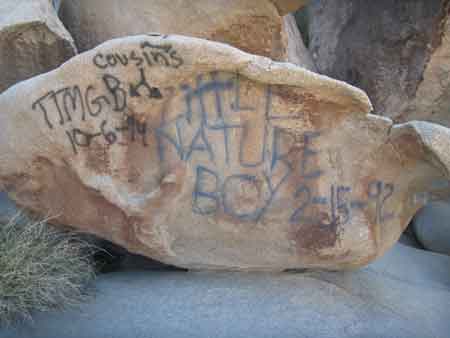Graffiti Since the Beginning of Time
As ubiquitous as its namesake trees were the laminated warning signs recently posted around Joshua Tree: “Rattlesnake Canyon Temporarily Closed Due To Vandalism.” In January, a few markings appeared on the massive boulders that pile into the air like the feces of God’s dog. Those responsible posted their work online, others trekked to the same spot to add their graffiti, and by April, “to protect park resources from further damage,” (Broken Window theory maybe) an emergency closure was declared—meant to last a month but, as of this writing, still in effect. Caught and convicted, those responsible could face fines up to $5,000 and six months in jail. Penalties could be greater, park rangers said, if these vandals are convicted of defacing historic Native American sites, locations where nomadic Indians once left petroglyphs scribbled on these same rocks. I didn’t speculate whether they were “vandals” when I visited the National Park recently. All my wonder was, why two groups, separated by centuries, felt the need to impose their writings on these rocks?
The connection between the Caves of Lascaux—where ancient cultures drew animals deep inside crevices—and modern graffiti has been overly discussed. Banksy even has a piece of a cleaner painting over the glyphs. Joshua Tree still has areas where glyphs left by the original visitors are visible, black etchings in not-too-hidden locations. Did these Native Americans face similar condemnation? Did the Chief chastise them for defacing Nature? Glyphitti? Maybe names were represented by animals in both the society of Lascaux and the Morongo Valley, and the glyphs were actually tags. I’m not suggesting people be allowed to tag Joshua Tree, or maybe I am (in certain locations)—and this is coming from someone who fantasizes about visiting JT. I’m only trying to understand why both visitors to this area were moved to mark the desert landscape, and if it’s the same reason why the city of Twentynine Palms, topping the park, is known, because of their abundance, as an Oasis of Murals.
Joshua Tree makes me existential in ways Sartre and the jerk professor who taught me about Sartre never could. Surrounded by trees older than I’ll ever be and rocks I can’t even conceive the age of, questions of how I fit into the grand scheme of nature, and my own mortality—not only because I’m named Joshua—emerge. Anything left erodes. Perspective is shifted—even if you’re not 5’4”, you feel insignificant. Marking these rocks is a way of saying “I was here,” but also of mastering the terrain by—as the rangers rightly say—denigrating it. Just as signs make a journey less scary, familiar images make the massiveness of this inhospitable terrain less overwhelming. Even with the rock piles, Joshua Tree has a horizontal plane, and both graffitists chose, as did the muralists, tall vertical spaces to project their images. A way of disrupting the seemingly non-disruptible flow of desert time. When it came time to share what they had done, these recent glyph-makers chose a telling location: their Facebook Walls.
Above: Graffiti at Rattlesnake Canyon, Photo: Courtesy The National Park Service


